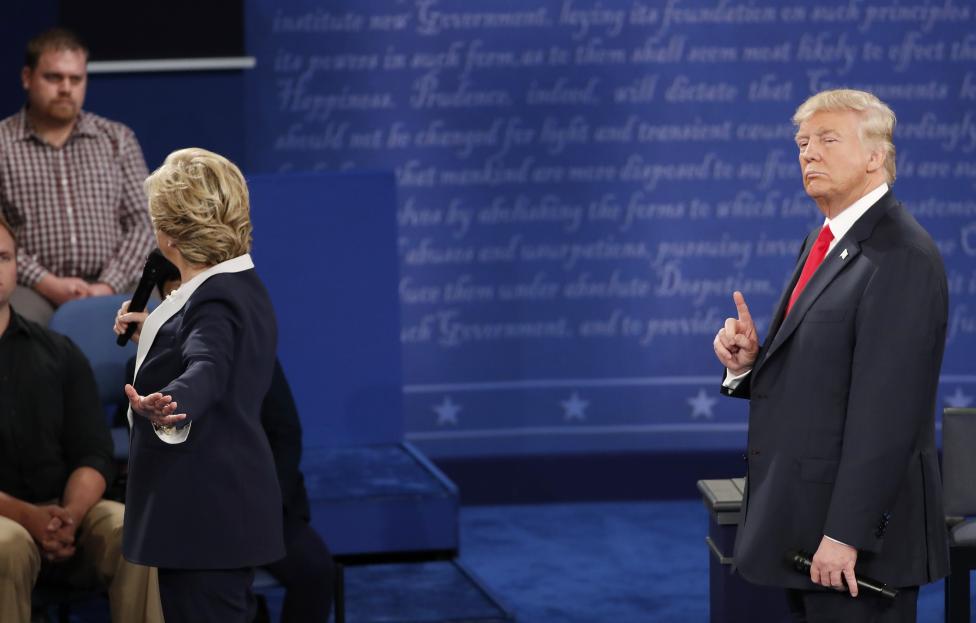London-If opinion polls are correct, the recent televised debates in the US presidential campaign have not produced a clear knock-out winner. The mainstream media declared Democrat nominee Hillary Clinton as the winner of the two first debates, albeit with a slim margin. That, however, may be more due to their intense dislike of Republican nominee Donald Trump who, it has to be admitted, seems to revel in making enemies as he goes along, than to any effort on the part of Mrs. Clinton.
The tradition of televised presidential debates started in1960 with the famous duel between Richard Nixon and John Kennedy. It reached a peak in 1980 when Ronald Reagan, a professional actor for a good part of his life, delivered the knock-out blow against incumbent President Jimmy Carter. For the rest, the televised debates were little more than part of the campaign ritual with no discernible effect on the outcome of the election.
This year’s Clinton-Trump debates, however, could be regarded as historic for at least one reason. They may have completed an historic cycle in which American life was transferred to television and then turned into TV reality show segment by segment.
The trend started with television, invented in the 1940s but popularized from the 1950s onwards, occupying the space hitherto reserved for radio networks in the form of musical concerts, performances by pop bands, quiz shows and sound drama. By the end of 1960s, television had all but replaced radio in all those domains.
The next space conquered by television was that of popular sports, especially baseball and American football. Within a decade, popular sport in America was transformed from something that people followed on stadiums into a show they watched on live television.
In the 1970s, television started capturing another space: that of cinema as features and serials made specifically for TV claimed a growing share of the market. Also from the late 1970s, especially with the emergence of cable networks, television invaded the space occupied by the printed press, especially as far as news was concerned. As newspaper and magazine circulations declined, the number of television viewers rose dramatically.
Alongside those developments, television started invading even the most private recesses of American life in the form of reality shows in which citizens supposedly volunteer to appear live on camera to wash their dirty linen in public.
It was inevitable that at some point the methods of reality TV would be extended to politics at the highest level. Such an eventuality was foreseen in Jerzy Kosinski’s 1979 novel “Being There” in which a gardener whose sole contact with realty is through television is accidentally propelled in front of the camera rather than the TV screen, and unwittingly changes the direction of political debate at national level. (The novel was turned into a film with Peter Sellers and Shirley MacLaine.)
That, however, was fiction imitating reality while the Clinton-Trump debates are reality imitating fiction.
Four features of the debates brought them close to reality TV and distanced them from traditional political clashes.
To begin with, this was the first time that we had candidates from both genders, making a he-said-she-said version of the Alphonse-Gaston routine possible. Had both candidates been men or women, we would have had less space for subliminal gender clashes, innuendos and outright vulgarities that provide the bread-and-butter of every reality TV show.
Next, largely thanks to Trump’s long experience as a reality TV show star, the debates put the emphasis on physical action rather than cerebral speculations.
This is how The New York Times moderator Jim Rutenberg put it: “Mr. Trump came in with a new philosophy: Give them a big, messy show with a regular stream of action, and they will come with their cameras and won’t turn them off.”
In Trump’s understanding of reality TV, the “performer” must enter into a dance with the camera. This is why he was moving like a bear in a cage, especially during the second debate, shaking his wig-covered head for additional effect.
The third reason why these debates were different is that they steered clear of anything resembling serious policy options. Largely under Trump’s influence both candidates used short sentences with a simple vocabulary, avoiding multi-syllable words.
They wanted to show that they think and talk in slogans and, at least in the second debate and again thanks to Trump, rely on what is euphemistically called “locker-room talk.” Thus, more time was spent on proving claims that former President Bill Clinton, Hillary’ husband, had been a philanderer, even a rapist, than on possible options for a new global strategy for the United States. Mrs. Clinton retaliated by focusing the searchlight on Trump’s juvenile misogynic boastings about his sexual prowess as captured on a video 11 years ago. That gave us reality TV par excellence.
The fourth feature of the debates was the scope it provided for actual threats of violence. To be sure, a streak of violence has always been part of American politics. But this was the first time that candidates for the highest office in the land were using thinly veiled threats against one another. Trump more than once threatened that, if elected president, he would try to land Mrs. Clinton in prison in connection with her controversial email account during her term as Secretary of State. Mrs. Clinton repaid the compliment by hinting that Trump should rather be in prison for having dodged paying US income tax for 18 years.
For those who like soap operas on the little screen, the debates were entertaining. But neither candidate really won because both lost to the real winner: the all-conquering television reality show.
